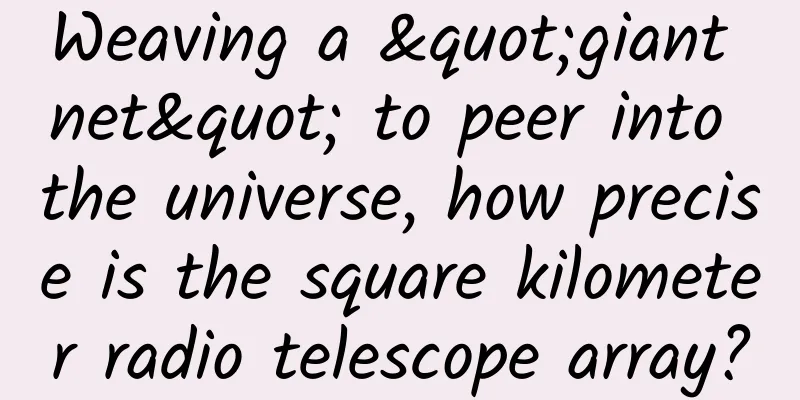Weaving a "giant net" to peer into the universe, how precise is the square kilometer radio telescope array?

|
Author | Zhou Jihao Audit | Huang Jian Editor | Zhao Jingyuan Radio astronomy is a discipline that studies astrophysical phenomena by detecting radio radiation from deep in the universe. The wavelength range of the radio band is very wide. The radio wavelengths that can be received from the ground range from a few millimeters to tens of meters. They can penetrate interstellar matter and the Earth's atmosphere and carry a wealth of astronomical information. However, traditional radio telescopes are limited by the size and sensitivity of the equipment and have difficulty capturing weak cosmic signals. The Square Kilometer Array (SKA), which is currently under construction, is like a magnifying glass, achieving unprecedented observation capabilities through a large-scale radio telescope array and advanced synthetic aperture technology. The first batch of SKA-Low antennas installed in March 2024 (Photo courtesy of SKAO) The construction of SKA is divided into two phases. The first phase was often referred to as SKA1 before, but is now commonly referred to as SKA. It includes two parts: the low-frequency aperture array (SKA-Low) and the medium-frequency aperture array (SKA-Mid). This phase started construction in December 2022 and is expected to be completed in 2028. SKA-Low is located in Australia and contains 131,072 small antenna units. Each antenna is about 2 meters high and shaped like a Christmas tree. The first batch of antennas was installed in March 2024. SKA-Low mainly receives low-frequency radio waves (50MHz to 350MHz) for studying the early stages after the Big Bang, especially the period of cosmic reionization. SKA-Mid will be built in South Africa and contains 197 parabolic antennas with a diameter of about 15 meters. It is responsible for receiving medium-frequency radio waves (350MHz to 15.4GHz) and providing high-resolution imaging for studying celestial bodies such as galaxies, pulsars and black holes. The SKA's expansion phase was previously known as SKA2. This phase is a vision for further construction in the future. Although the specific construction content and timing are still under discussion, it is expected that more antenna arrays will be added around the world to further enhance the sensitivity and resolution of the telescope. SKA-Mid artistic conception (picture from SKAO) After its completion, SKA will undertake many scientific research tasks, such as cutting-edge topics such as microwave background radiation, galaxy evolution and large-scale structure, and fast radio bursts. The cosmic microwave background (CMB) is the afterglow left when the universe cooled from high-temperature plasma to a temperature capable of forming neutral hydrogen about 380,000 years after the Big Bang. However, observations of the CMB are often interfered with by foreground radio sources (radio emissions from celestial bodies such as galaxies and quasars). The SKA's high sensitivity and wide frequency coverage can help accurately measure these foreground signals, especially the synchrotron radiation of the Milky Way and the radio emissions of quasars. As a result, scientists can more effectively remove foreground interference from CMB data, thereby improving the accuracy of CMB observations and further revealing the physical state and evolution of the early universe. At the same time, the SKA's observational capabilities will enable it to detect high-redshift galaxies, which may have been the main contributors of photons during the cosmic reionization period. By understanding the properties and evolution of these galaxies, scientists can better understand the processes of the reionization period and improve the CMB model. Cosmic microwave background radiation image (Image from ESA) The SKA can provide a detailed picture of the large-scale structure of the universe through precise measurements of galaxies and galaxy clusters. These observations can be combined with CMB data to help accurately determine basic parameters of the universe, such as the Hubble constant, matter density parameters, and dark energy parameters. In addition, the system can also help measure the distribution of dark matter in the universe by observing the gravitational lensing effect, and combine its data with the CMB lensing effect observations to provide a more comprehensive picture of the distribution of matter in the universe. Artistic conception of a fast radio burst reaching Earth (Photo courtesy of Beijing Planetarium, drawn by Yu Jingchuan) SKA can also make timely observations of some sudden events. Fast Radio Bursts (FRBs) are short but extremely intense radio bursts that last only a few milliseconds. Precisely because of their suddenness and brevity, the observation and study of FRBs are full of challenges. SKA's high sensitivity and rapid response make it an ideal tool for studying FRBs. By monitoring a large area of the sky in real time, SKA is expected to capture more FRBs events and provide precise positioning information to further reveal the source of FRBs, allowing astronomers to conduct in-depth research on the physical mechanisms of these events, such as neutron star mergers, black hole accretion, or violent activities in the center of galaxies. As of July 2023, the distribution of countries participating in the construction of SKA (picture from SKAO) In March 2019, in order to coordinate construction and operation, seven founding member states (Australia, China, Italy, the Netherlands, Portugal, South Africa and the United Kingdom) established the Square Kilometer Array Observatory (SKAO) in Rome, Italy, with its headquarters located at the Jodrell Bank Observatory in the United Kingdom. Currently, the number of member states and observer states of SKAO has increased to 16, and eight African countries have also participated in the coordination, and more countries will participate in the future. As the world's largest radio telescope array, SKA is like a giant net weaving on Earth to capture the mysteries of the universe. As SKA is gradually built and put into use, mankind will make breakthroughs in many fields, while greatly promoting the development of astronomy and helping mankind further reveal the mysteries of the universe. References [1] Wu Manqing, Cao Rui, Tao Xiaohui, et al. Research on the low-frequency digital array system of the world's largest synthetic aperture telescope SKA[J]. Scientia Sinica: Information Sciences, 2015, 45 (12): 1600-1614. [2] Chen Xuelei, Shi Huli. Tianlai Project: Radio Detection of Dark Energy and the Square Kilometer Array (SKA) [J]. Physics, 2013, 42 (01): 2-11. [3] Zhang Weicheng. Why do we need SKA? [J]. Encyclopedia Knowledge, 2012, (13): 4-8. [4] Wei Xing. Square Kilometer Array (SKA)[J]. Chinese Science and Technology Terminology, 2018, 20(3):79-79. [5] Yan Guofeng, Li Changhui, Chen Liang, Zhang Runtao, Liu Lijia. Square Kilometer Array (SKA)[J]. Journal of Sichuan Ordnance, 2010, 31(10):124-127. [6] Porter. Building a “giant eye” to peer into the universe: an introduction to the Square Kilometer Array radio telescope[J]. Space Exploration, 2012(7):46-47. [7] Er Dong. Experts interpret the world's largest radio telescope array[J]. Space Exploration, 2012(2):50-51. [8] The Square Kilometre Array, Australia Telescope National Facility, https://www.atnf.csiro.au/projects/SKA/index.html [9] The SKA telescopes, SKAO, https://www.skao.int/en/explore/telescopes [10] SKA Observatory celebrates start of telescope construction in Australia and South Africa, SKAO, https://www.skao.int/en/news/441/ska-observatory-celebrates-start-telescope-construction-australia-and-south-africa [11] Jonathan Amos, SKA: Construction to begin on world's biggest telescope, BBC, https://www.bbc.com/news/science-environment-63836496 [12] SKA telescope specifications, SKAO, https://www.skao.int/en/science-users/118/ska-telescope-specifications For more questions about the Square Kilometer Array, please leave a message in the comment section and Xiaoxing will answer them for you one by one~ Follow the Toutiao account/Science Popularization China/WeChat public account/Sina Weibo "Xingming Observatory" and walk through the stars with Xiaoxing to harvest romance~ |
<<: "Meow meow" has different meanings. Here's how to interpret cats' little tricks in one second
Recommend
Lake Nyos incident: The lake did not overflow, but more than a thousand people suffocated to death
In the summer of 1986, a villager near Lake Nyos ...
Bilibili sideline money-making project, attracting traffic and selling virtual products for 50-300 yuan a day
A netizen said that the salary is too low. Is the...
Things to know about Android compilation
As an Android engineer, we go through countless c...
Want to grow your user base quickly? How can you succeed if you don’t understand fission distribution!
We see more and more course posters in WeChat Mom...
[Bugly practical sharing] Android APP quick pad implementation
MicrosoftInternetExplorer402DocumentNotSpecified7....
Analysis of Guazi used car competitors!
Guazi, Youxin, Renren, the names of these second-...
Yan Xiaoyun built Alibaba's iron army in 10 days
Yan Xiaoyun: Building Alibaba's Iron Army in ...
Title creation method: How to choose a title for a recommendation channel?
Regarding the skills of choosing titles , I think...
What! You may not be suitable for sleeping like this? Come and "claim" the sleeping position that suits you best
The quality of sleep affects a person's physi...
What are the advantages of bidding software compared to other software?
Many people who do Baidu bidding promotion will u...
Should wisdom teeth be removed? If it doesn't hurt, you can just leave it alone? Here are all the answers about wisdom teeth
Most people don’t know they have wisdom teeth. So...
Bright blue iPhone 7 stunning unboxing in China: third-party customized luxury packaging
Apple has spent a lot of effort on the iPhone 7, n...
Who do mosquitoes like to bite? Scientists have found the smell of human "greasy molecules"
There have long been theories about who is more l...
Mysterious creatures in the ocean have mastered fiber optic technology that surpasses humans
If you dive in the warm Indian-Pacific waters nea...
What is the secret behind TikTok’s explosive user growth?
Think first: How do you measure user growth ? Wha...









